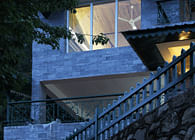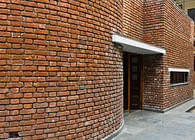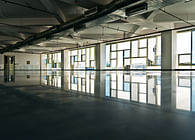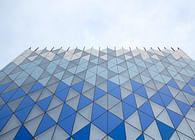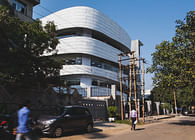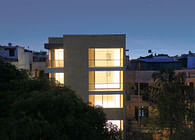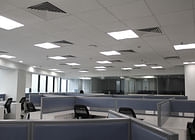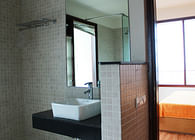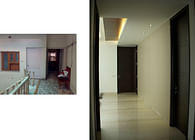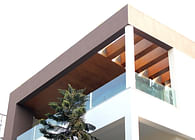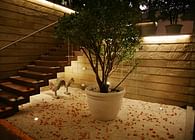
New Delhi, IN
The Ridge is a northern extension of the ancient Aravalli Mountain Range in North India, some 1500 million years old. Mostly rocky quartzite, it extends from the Southeast, branching out in places and tapers off in the north of the city on the west bank of the river Yamuna. Notoriously hard to build on, the ridge has an undulating topography, with higher points occupied by older religious structures and the lower lying land used for row housing. The client previously occupied a small two storey house on the site in a prime location of New Delhi, that abutted a large rocky outcrop at the rear, rising almost 25 feet above the front road. Current byelaws permitted a five-storey building on the land, with four of the upper floors being residential, while lower floors can be used for parking, services and storage.
While the left side of the site was hedged in with a 50 ft high party wall, the right side opened up into a central garden carved out by the neighbours who also happened to be architects. Driven by the design brief and as architects, we wanted to preserve the quality of light in the house, and therefore the building outline closely follows theirs, inverting it to create a double- shared courtyard. This communal open space was designed to be mutually beneficial, with the possibility of growing trees in the central space in the future, a rarity in the otherwise cheek-by-jowl approach of local residential developers.
Each of the residential floors has been treated differently to extract the maximum buildable volume, while ensuring plenty of open space, light and ventilation. Since the footprint of the ground floor determined the size of the subterranean level, it was maximised and split into two apartments arranged around the courtyard with independent access from the parking level, hence designed specifically for tenants. The floor above it reduces in size and being a single apartment meant for the grandparents, it benefited by getting a large sun facing terrace at the rear, a luxury unheard of in multi-storey housing. The third residential level is designed with an intention to be rented out to tenants, while the three-bedroom penthouse on the top floor was to be occupied by the client whenever he would be in the country. This opened up to the generous terrace, meant for entertaining, complete with a bar counter and water landscaping.
Creating a five-storey building on a foundation of pure rock was one of the immediate challenges of this project. Unable to use hydraulic splitters or explosives due to the residential neighbourhood, we were forced to rely on manual labour to excavate large portions of the foundations. The sheer mass of the rock meant that no retaining wall would be needed and the decision was taken to leave the stone surfaces exposed in the interiors of the basement, simultaneously lighting them from above through slits in the stilt level. Aligning the needs of multiple floors that all follow different floor plans from a structural perspective was also a challenge, since the basement needed a large column free space that would allow religious congregations. The parking on the upper floor is designed to cater to both tenants and family, and was achieved by creating two zones of parking, one in the front and the other to the rear of the building.
Guided by the pleasing aesthetic of the reddish colour of the excavated stone, the exteriors have been designed in brick, which unifies the otherwise complex volumetric nature of the building. Substantial portions of the facade are screens that are created by combining regular sized bricks with thinner ones to create an irregular pattern of openings that modulate the fierce exterior light. These screens help protect the long west-facing courtyard facade from the evening sun, whilst allowing considerable glare-free light to percolate within the house. Privacy for individual floors is also enhanced by using the screen strategically at the rear of the house. The only other material used on the facade is a locally available hardy stone known colloquially as Kota (for its place of origin). To mask the inherent colour variation in the stone, a grooved pattern is used, which also helps to mitigate the visual impact of multiple stone joints. Kota stone has beenused as the flooring in the parking floor, interspersed with small pieces of black granite, that is saved from the wastage of the countertops.
An essential aspect of this project is the need for multi apartment projects in India to be more sustainable, both by consuming lesser energy and being more efficient in managing daylight, air quality and thermal comfort. Custom designed double glazed windows with protective dust seals in the openable shutters are used throughout the building, increasing thermal comfort and reducing the amount of air borne dust that enters the building. LED lights are used for all lighting, both direct and indirect, eliminating the need for decorative light fixtures. A 5 star energy rated, variable refrigerant flow air conditioning system from Mitsubishi is used on all floors and coupled with standalone air purifiers, help control the ambient air quality for thermal comfort and health. Double insulation on the roof ensures minimum heat gain for the upper floor and the brick screens mitigate the solar gain from the elevations.
Status: Built
Location: New Delhi, IN
Firm Role: Architect
